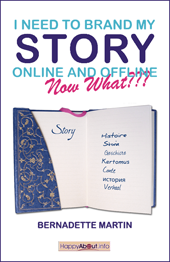I just attended a webinar delivered by Bernadette Martin, a Paris-based American who has a new book coming out soon, I Need to Brand My Story Online and Offline — Now What???. Martin’s work has a lot in common with my Tell Me About Yourself: Storytelling to Get Jobs and Propel Your Career.
Her focus in this webinar was storytelling in LinkedIn profiles and elevator pitches.
A starting point, Martin says, is a Bio Tool, one of three key tools in a personal-branding toolkit (the other two are one’s resume and references). She notes that a bio is not a static document, and you can have bios for many situations. She mentioned having about 19 versions of her bio.
Some of the most interesting parts of the webinar sprang from audience questions and comments. Martin talked about making an emotional connection with one’s audience by integrating storied elements into resumes, bios, and LinkedIn profiles, prompting an audience member to ask about discrimination issues. We’ve long been taught to keep personal information out of career correspondence, especially resumes, so that employers won’t be tempted to discriminate. Legal and discriminatory concerns are a huge emerging issue as more and more recruiters are using social-media venues — which are replete with photos and the kind of information that can get candidates screened out — to source candidates. I don’t know how these discrimination questions will be resolved, but I favor the storytelling possibilities in social-media profiles and more — rather than less — personal information in career-marketing communication.
Considerable discussion ensued over the question of first-person Linked-In profiles vs. third-person. While Martin acknowledges that both options are viable, she prefers third person because it’s more “professional.” She completely contradicted everything she’d previously said about using stories to make an emotional connection by asserting that third person is preferable because it’s more “detached.” Hmmmm … that would seem to be the opposite of an approach that makes an emotional connection.
One of Martin’s main arguments against first person is that first-person profiles tend to repeat “I, I, I.” Several audience members pointed out that it’s possible to use first person without beginning every sentence with “I.” Others noted that the profile should target “you” the reader and take more of a second-person approach in which the profilee tells what he or she can do for you. Jason Alba, host of the webinar and a LinkedIn expert/author, favors the first-person approach, and I agree with him. It’s much more personal and makes an emotional connection much better than third person. I also note that resumes are written in first person (with the actual “I” unspoken but understood), and in the research I’ve conducted, hiring decision-makers loathe resumes written in third person. A resume is not the same as a Linked-In profile, but they are close enough that hiring decision-makers’ first-person preference likely applies.
I like my LinkedIn profile and feel it is reasonably storied (and branded), but one thing I realized from the webinar is that its paragraphs are way too long. That’s because LinkedIn limits the user to 2,000 characters. I remember editing and editing to get mine down to that and finally reducing space between paragraphs to eliminate characters. Looks like I need to do more slicing and dicing.
Tomorrow I’ll discuss the webinar’s take on elevator pitches.
